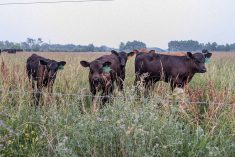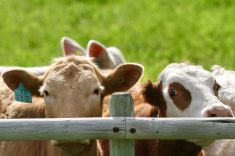Media attention has been focused lately on how livestock manure affects the health of Lake Winnipeg, but a University of Manitoba soil scientist says cattle producers need to start protecting their own water supplies.
“Nobody as far as I know has lost an animal due to blue-green algae toxicity in Lake Winnipeg, but farmers every year in Manitoba lose some livestock due to algal toxins in local reservoirs,” Don Flaten told the Manitoba Zero Tillage Research Association annual summer farm tour near Brandon.
“If we can do a good job of recycling nutrients on the farm and keeping nutrients from building up to excessive levels, especially near water sources, it’s going to be beneficial for our own productivity on the farm, plus it’s going to keep the water in better condition for ourselves as well.”
Read Also

U.S. farm group supports supply management
U.S. grassroots farm advocacy group pushing new agriculture legislation that would move towards supply management like Canada has for dairy industry
Studies have shown that a cow excretes 80 percent of nutrients it consumes, Flaten said, and it can be difficult for producers to replace the remaining 20 percent that is exported from the farm in the form of a calf or finished animal.
“On pastures, this small withdrawal of nutrients, typically only three to five pounds of phosphorus that is removed every year, can be a bit of challenge.”
For thousands of years, nutrients from buffalo that died on the open range were cycled back into the soil. Nowadays cattle are exported to other countries or eaten by urban residents, whose “manure” is channeled off through sewage treatment plants into rivers and eventually ocean. For this reason, most farms are faced with a problem of depletion over the long term.
Planting legumes on forage land can help, as can buying hay from areas blessed with an excess of nutrients.
“Synthetic fertilizers and external sources of manure may not be affordable or in good supply. That puts the pressure on us to start recycling nutrients more locally.”
Using pastures or hay production land as overwintering sites offers a tremendous boost in productivity, he added, but while tame forage species prefer higher nutrient levels, thrifty native grasses don’t respond as well.
“If you add nutrients to a native pasture, you will probably alter the distribution of species,” he said.
“A massive injection of additional nutrients, whether it is from synthetic fertilizer or livestock manure from an overwintering site, is going to favour the invasion of new species and discourage the native species.”
Every tonne of alfalfa hay represents 60 pounds of nitrogen, 12 lb. of phosphate, 60 lb. of potash and six lb. of sulfur.
“That’s about $55 worth of nutrients per tonne from a fertilizer standpoint,” Flaten said. “In terms of feeding practices, 80 percent, or about $40 worth, is going to be deposited where that bale is fed.”
Grass hay tallies up a bit lower, he said, at 30 lb. of nitrogen, eight lb. of phosphate, 50 lb. of potash and five lb. of sulfur.
“That’s about $35 per tonne worth of nutrients in that grass,” he said. “Eventually, you have to replace those nutrients that you are taking off that field.”
Alfalfa fixes its own nitrogen, but mineral nutrients such as phosphorus, potassium and sulfur must be replaced.
“In an ideal haying and feeding system, you would be going back to those haying fields and feeding where you collected those nutrients so that you could recapture the benefit of the 80 percent that is excreted out the back end of the animal.”
Not only does recycling manure back onto hay fields save money, it also reduces the risk of too many nutrients concentrating in one area where it can eventually affect local water supplies.
Flaten said that at the U of M’s La Broquerie hog-manure-on-forages research site, concentrations of phosphorus around watering sites are already 10 to 20 times higher than in the rest of the field after only two years of grazing.
When pathogens and nutrients are concentrated in an area where there is no plant growth due to trampling by cattle, a “window” to the water table is created that could cause problems in the future.
“I think we have to take advantage of some of the newer technologies to move our water supplies around and avoid bare areas of soil that can be a problem both in terms of productivity and environmental risks,” he said.














